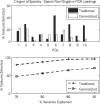Sparse non-negative generalized PCA with applications to metabolomics
- PMID: 21930672
- PMCID: PMC3198582
- DOI: 10.1093/bioinformatics/btr522
Sparse non-negative generalized PCA with applications to metabolomics
Abstract
Motivation: Nuclear magnetic resonance (NMR) spectroscopy has been used to study mixtures of metabolites in biological samples. This technology produces a spectrum for each sample depicting the chemical shifts at which an unknown number of latent metabolites resonate. The interpretation of this data with common multivariate exploratory methods such as principal components analysis (PCA) is limited due to high-dimensionality, non-negativity of the underlying spectra and dependencies at adjacent chemical shifts.
Results: We develop a novel modification of PCA that is appropriate for analysis of NMR data, entitled Sparse Non-Negative Generalized PCA. This method yields interpretable principal components and loading vectors that select important features and directly account for both the non-negativity of the underlying spectra and dependencies at adjacent chemical shifts. Through the reanalysis of experimental NMR data on five purified neural cell types, we demonstrate the utility of our methods for dimension reduction, pattern recognition, sample exploration and feature selection. Our methods lead to the identification of novel metabolites that reflect the differences between these cell types.
Availability: www.stat.rice.edu/~gallen/software.html.
Contact: gallen@rice.edu.
Supplementary information: Supplementary data are available at Bioinformatics online.
Figures




References
-
- Allen GI, et al. A generalized least squares matrix decomposition. USA: Technical Report No. TR2011-03. Rice University; 2011.
-
- Bollard M, et al. NMR-based metabonomic approaches for evaluating physiological influences on biofluid composition. NMR Biomed. 2005;18:143–162. - PubMed
-
- Coen M, et al. NMR-based metabolic profiling and metabonomic approaches to problems in molecular toxicology. Chem. Res. Toxicol. 2008;21:9–27. - PubMed
-
- Crockford D, et al. Curve-fitting method for direct quantitation of compounds in complex biological mixtures using 1h NMR: application in metabonomic toxicology studies. Anal. Chem. 2005;77:4556–4562. - PubMed
-
- De Graaf RA. In Vivo NMR Spectroscopy: Principles and Techniques. West Sussex, England: John Wiley & Sons; 2007.

